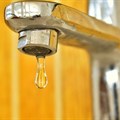On 9 August, the Intergovernmental Panel on Climate Change sounded the alarm that the challenges created by climate change is 'code red for humanity'. Water security is intricately linked to climate change. We need to find ways to build climate resilience into our water systems.

Dr Shafick Adams, executive manager, Water Research Commission
As our climate continues to change and our weather variability continues to swing between the extremes, we need to continue to develop mitigation and adaptation measures. Even when the precipitation amount does not decrease, we observe that the rainy season downpours are compressed into a few weeks and even days, resulting in localised flash flooding and overwhelming of the stormwater infrastructure.
Humans have developed techniques to keep some of this water for as long as possible in the landscape to ensure that they can meet their water needs. Some water infiltrates and percolates into the subsurface to aquifers, some is stored in depressions, dam walls keep some back. This provides a means for domestic, food and energy security. In these environments, the water evaporates from open surfaces or are transpired by vegetation.
In dry and hot environments, potential evaporation is significantly higher than precipitation – a significant amount of water is returned to the atmosphere. Annual evapotranspiration depends on rainfall and potential evapotranspiration and can be over 50% of annual precipitation. It is not practical to cover all our open surfaces to reduce evaporation, but there is one place where we can store our water and that is right under our feet in suitable aquifers where the water is protected from open evaporation. Aquifers are subsurface formations that can store and transmit water in spaces found in unconsolidated material (pores) and hard rock (pores, joints, cracks, faults). Water security can be greatly enhanced by capturing and storing water that would otherwise return to the atmosphere.
Thamsanqa Mbovane 29 Jul 2021 Water banking
In the arena of water security enhancement, one such measure is directing excess surface water, that would otherwise evaporate or flow into the sea, into the subsurface to be stored in suitable aquifers. The stored or banked water can later be abstracted via boreholes for when there is demand or to buffer drought episodes. Redirecting and storing excess surface water is called artificial recharge or managed aquifer recharge (MAR) – I prefer water banking. Research by the Water Research Commission and implementation by the Department of Water and Sanitation as well as a few municipalities have shown that the technology works. Many of these schemes are operated across the globe. There are only 52 readily identifiable MAR schemes in Africa, with South Africa having 11 operational schemes, using a variety of approaches with surface spreading infiltration, open well and direct borehole injection being the most favoured.
In southern Africa, we have excellent case studies but limited uptake of this proven technology. In the Western Cape, the Atlantis scheme was developed in 1979 and receives treated domestic wastewater and stormwater that is directed to the subsurface via stormwater detention ponds. Windhoek is one of the driest countries in the region, and it receives an average of 360mm of rainfall per year and average evaporation of 2170mm per year. During 1997-98, Windhoek conceptualised banking water in its surrounding aquifers as an alternative to importing water from the far-away Okavango River. Injection into the fractured aquifers started in 2006 and in 2012 the recharge area could not receive any more water and the second phase went into the planning phase.
Today, Windhoek operates a world-class water scheme and even more impressive is the coupling with their world-class wastewater reuse scheme. Their direct wastewater reuse scheme has been running for over 50 years and is the gold standard of how to do this. South Africa again helped to develop the technology. In addition, this has been done on the back of public-private partnerships and accessing know-how from elsewhere. For those that are still skeptical at this stage, the scheme ensured Windhoek remained water-secure during the 2015/16 drought. The investment yielded a healthy dividend for the city.
SA a water scheme trendsetter
On the African continent, South Africa is indeed the trendsetter with several schemes, and it also has an Artificial Recharge Strategy (ARS) that was developed back in 2007. The ARS has as its vision statement, “To use natural sub-surface storage as part of integrated water resources management wherever technologically, economically, environmentally and socially feasible.”
South Africa currently has 37 schemes at various stages of development (five at desktop assessment; 15 active investigation report stage; four planning stage; two active pilot injections; and 11 fully implemented schemes). We, indeed, have a wonderful story to tell. South African experts were central to the development of the Windhoek scheme, other neighbouring countries are also importing our skills to help develop MAR systems. Many astute planners are developing their infrastructure (for future use) to redirect excess surface water into their aquifers.
So why, if we have the policy and strategy, the skills and know-how as well as ticking all the why, what, and how boxes, are we still relatively slow in taking up this technology that is a sure-fire way to improved water security? Institutionally, we like bulk schemes with high capital costs. This can be exemplified by a seaside town - that between two options (MAR and desalinisation) selected a desalinisation plant that was six times more expensive than a MAR scheme offering similar yields. The operation and maintenance of smaller and decentralised schemes are difficult and poorly managed due to the absence of hydrogeological expertise at the municipal level. We would find it ridiculous not to have electrical expertise available in municipalities, but municipalities that rely on groundwater for water security do not have any hydrogeological expertise.
Dhesigen Naidoo 17 Jun 2021 Accessing skills and know-how
It is rarely the case that groundwater as a resource fails, instead the failure is often in the day-to-day management of the resource and associated infrastructure. The technical skills often reside in private and academic institutions. The notion of low capacity often cannot be substantiated, it is more an issue of accessing these skills and know-how. It is time that we invest in proper groundwater development and management to ensure water security at all scales, as well as using our aquifers to store excess water for use during peak demand and droughts. The water security and climate resilience rewards from compounding yields through better choices and changes in our institutional behaviours will benefit our socioeconomic aspirations. The more we implement the technology, through iterative experiences with time, the more robust and cost-effective it will become and downgrade the code red alarm.











































